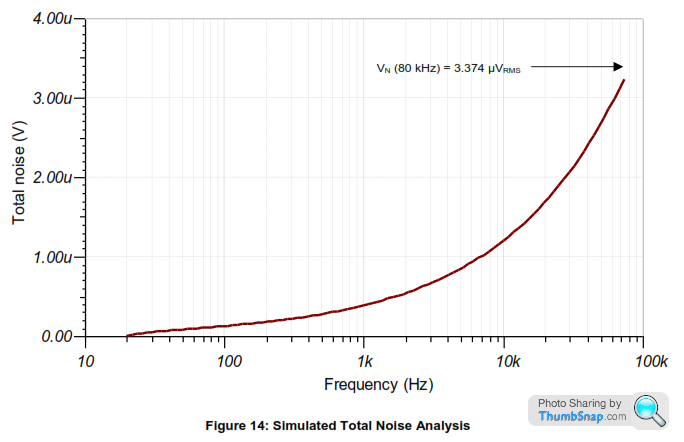Help with a mathematics formula please anyone?
Discussion
EliseNick said:
No idea! What's the context?
Apologies for the delay in replying.The context is calculating THD+N (distortion + noise) for an audio preamplifier.
The article reads as follows (extract):
However, the THD+N ratio of a circuit can be predicted from the total noise by using Equation 10, where V is the total voltage noise in Vrms over a specified bandwidth and VF is the fundamental signal amplitude in Vrms

The result of the simulated total noise analysis at unity gain is shown in Figure 14. The audio analyzer
which will be used for real-world measurements will be set to a maximum bandwidth of 80 kHz, so this
simulated analysis is performed to 80 kHz.

The total noise at 80 kHz was found to be 3.374 µV RMS. Given our input signal amplitude of 1.228 V,the predicted THD+N ratio was calculated using Equation 11.

The simulated THD+N ratio was found to be 0.000275%, which meets the design requirement of 0.0005%.
TonyRPH said:
Apologies for the delay in replying.
The context is calculating THD+N (distortion + noise) for an audio preamplifier.
The article reads as follows (extract):
However, the THD+N ratio of a circuit can be predicted from the total noise by using Equation 10, where V is the total voltage noise in Vrms over a specified bandwidth and VF is the fundamental signal amplitude in Vrms

..snip
OK. Well, it's a bit wierd, but consider the first equation in this;The context is calculating THD+N (distortion + noise) for an audio preamplifier.
The article reads as follows (extract):
However, the THD+N ratio of a circuit can be predicted from the total noise by using Equation 10, where V is the total voltage noise in Vrms over a specified bandwidth and VF is the fundamental signal amplitude in Vrms

..snip
https://en.wikipedia.org/wiki/Total_harmonic_disto...
Along the top line are the sum of voltages squared, because you're adding noise (or distortion) power, which is proportional to V^2. Then the V_F on the bottom could be squared and inside the root. So your normalising the sum of powers by dividing by another power. So far so good. Then to get a voltage ratio you take the square root.
In your text, they appear to have left the V^2 in for no great reason, because they've scooped up everything in the V_N as far as I can see. I guess it acts as a reminder that you are in some sense adding powers rather than voltages.
EliseNick said:
OK. Well, it's a bit wierd, but consider the first equation in this;
https://en.wikipedia.org/wiki/Total_harmonic_disto...
Along the top line are the sum of voltages squared, because you're adding noise (or distortion) power, which is proportional to V^2. Then the V_F on the bottom could be squared and inside the root. So your normalising the sum of powers by dividing by another power. So far so good. Then to get a voltage ratio you take the square root.
In your text, they appear to have left the V^2 in for no great reason, because they've scooped up everything in the V_N as far as I can see. I guess it acts as a reminder that you are in some sense adding powers rather than voltages.
All of the maths on the Wiki page went completely over my head!https://en.wikipedia.org/wiki/Total_harmonic_disto...
Along the top line are the sum of voltages squared, because you're adding noise (or distortion) power, which is proportional to V^2. Then the V_F on the bottom could be squared and inside the root. So your normalising the sum of powers by dividing by another power. So far so good. Then to get a voltage ratio you take the square root.
In your text, they appear to have left the V^2 in for no great reason, because they've scooped up everything in the V_N as far as I can see. I guess it acts as a reminder that you are in some sense adding powers rather than voltages.
Gassing Station | Science! | Top of Page | What's New | My Stuff



